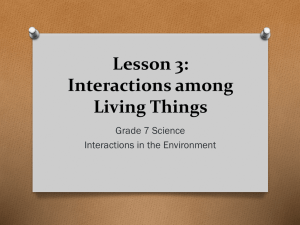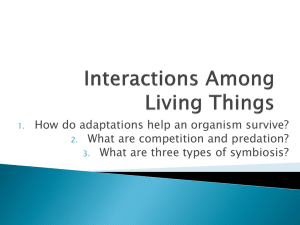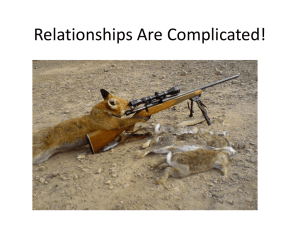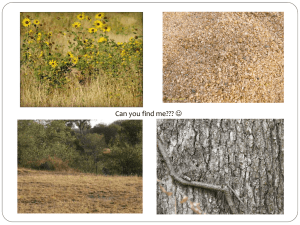Chapter 16
advertisement
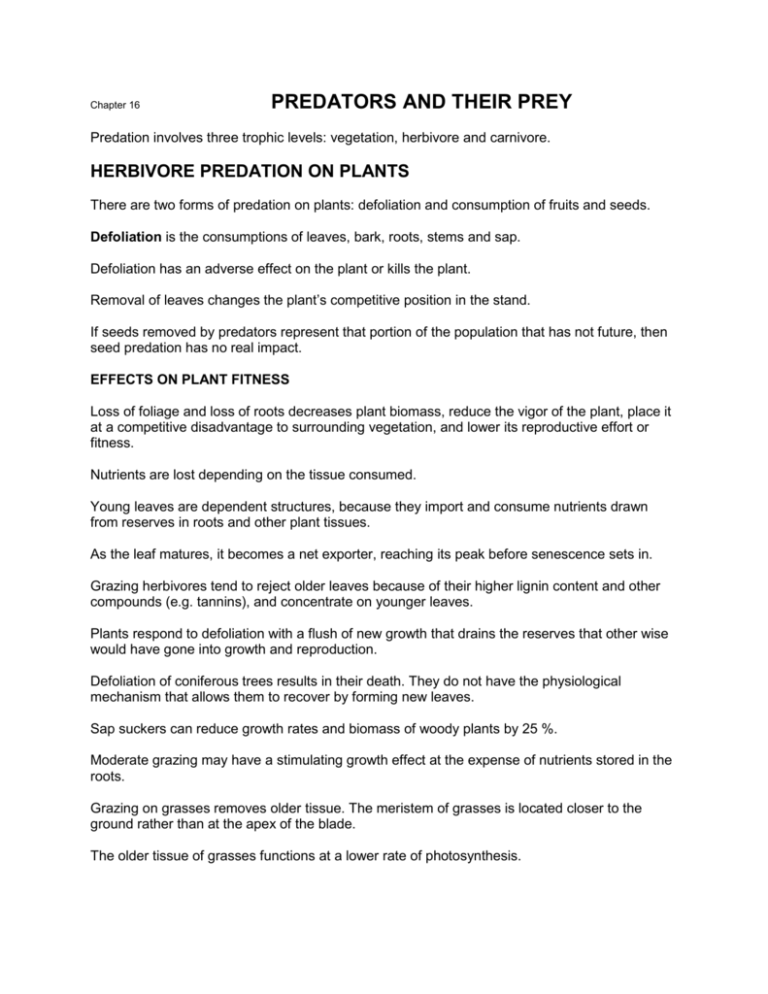
Chapter 16 PREDATORS AND THEIR PREY Predation involves three trophic levels: vegetation, herbivore and carnivore. HERBIVORE PREDATION ON PLANTS There are two forms of predation on plants: defoliation and consumption of fruits and seeds. Defoliation is the consumptions of leaves, bark, roots, stems and sap. Defoliation has an adverse effect on the plant or kills the plant. Removal of leaves changes the plant’s competitive position in the stand. If seeds removed by predators represent that portion of the population that has not future, then seed predation has no real impact. EFFECTS ON PLANT FITNESS Loss of foliage and loss of roots decreases plant biomass, reduce the vigor of the plant, place it at a competitive disadvantage to surrounding vegetation, and lower its reproductive effort or fitness. Nutrients are lost depending on the tissue consumed. Young leaves are dependent structures, because they import and consume nutrients drawn from reserves in roots and other plant tissues. As the leaf matures, it becomes a net exporter, reaching its peak before senescence sets in. Grazing herbivores tend to reject older leaves because of their higher lignin content and other compounds (e.g. tannins), and concentrate on younger leaves. Plants respond to defoliation with a flush of new growth that drains the reserves that other wise would have gone into growth and reproduction. Defoliation of coniferous trees results in their death. They do not have the physiological mechanism that allows them to recover by forming new leaves. Sap suckers can reduce growth rates and biomass of woody plants by 25 %. Moderate grazing may have a stimulating growth effect at the expense of nutrients stored in the roots. Grazing on grasses removes older tissue. The meristem of grasses is located closer to the ground rather than at the apex of the blade. The older tissue of grasses functions at a lower rate of photosynthesis. PLANT DEFENSES AGAINST HERBIVORES Because of the complex digestive process needed to break down plant cellulose and convert plant tissue into animal flesh, high quality forage is necessary. High quality foods are young, soft and green, or they are stored in roots, tubers and seeds. Low quality foods are fibrous and woody, and indigestible. 1. Morphological defenses include thorns, spines, hairs, cell wall thickening, rapid proliferation of cells, and calcification of some algae. 2. Chemical defenses include the accumulation of compounds that make the plant parts difficult to eat, hard to digest, unpalatable, repugnant or toxic. Chemical defenses. Protective chemicals are called secondary compounds since they are not essential for the metabolic processes of the plant. substances not produced as part of primary metabolism in plant; frequently with an uncertain function; possible allelochemics between insects and plants. allelochemics are secondary substances capable of modifying the growth, behavior or population dynamics of other species through inhibitory or regulatory processes. These compounds cover a wide range of organic chemicals: toxic proteins, tannins, terpenes, alkaloids, phenolics, resins, steroidal, cyanogenic and mustard oil glycosides and tannins (contain aromatic rings, some are glycosides). Phenolics are very common amino acid derivatives found in seed-producing plants; they are the burning substances in poison ivy and poison oak. Alkaloids are also amino acid derivatives found thousands of species of plants. Cyanogenic glycosides are found in a few hundreds of species. Glycosides are oligosaccharides bound to alcohols, phenols or amino groups. They usually interfere with the formation of ATP. These chemicals are often stored in vacuoles and released only when the cells are destroyed. Epidermal glands produce some chemicals to function as contact poisons or volatile inhibitors. Quantitative inhibitors interfere with digestive enzymes. They are mostly tannins and resins that accumulate on the surface of leaves, bark and seeds. Qualitative inhibitors interfere with metabolism. They are effective at low concentration and can be transported readily from growing points to seeds, leaves and bark. Alkaloids like mescaline, nicotine, cocaine and morphine fall under this category. Some plants produce animal hormones or mimic them in order to induce early metamorphosis, decrease fertility, slow down metabolism, difficult labor, etc. Secondary compounds may also function as warning odors, repellents, attractants, or direct poisons. Qualitative response involves highly toxic glycosides, alkaloids and other secondary compounds; they are effective in low concentration and quickly transported to the site of attack. Plants that use qualitative responses are usually short-lived perennials and annuals. The substances are stored in vacuole, glandular hairs and resin-latex systems. These chemicals interfere with metabolism and disrupt insect development. Quantitative responses are often terpenes, saponins, tannins and resins. They are slow in acting and depend on plant tissue being eaten in large amounts, and the chemicals are not easily mobilized. They are produce near the surface of the bark, leaves and seeds. Usually found in long-lived plants, e.g. oaks. The plant produces these chemicals in large amounts only when stimulated to do so by an herbivore attack. Such a response may last for several years. This is called induced resistance. Herbivore countermeasures to chemical defenses. Plant chemicals are advantageous to the animals that can tolerate them: Specialists can detoxify the harmful substance. Vertebrates do it in the liver; insects detoxify in the gut and Malpighian tubules. Detoxification is done by a system of mixed function oxidases (MFO) that oxidase, reduce and hydrolyze toxic chemicals into soluble molecules that can be eliminated. MFO is a general detoxifying agent, and it is induced into activity by a wide range of toxic chemicals. The MFO is ubiquitous in animals and requires little genetic change to adapt to newly evolved toxic chemicals. Insects in particular are preadapted to handle many toxic, unrelated chemicals. Mixed function oxidase activity in vertebrates is located in the liver; in insects, in the gut, fat bodies and Malpighian tubules. Fewer or no competitors to eat the harmful plant. Animal becomes poisonous by incorporating the plant chemicals. Some insects cut the flow of chemicals by cutting the veins that supply the toxic chemicals to the intended place of feeding. A compound found in grass serves as a reproductive cue to the montane vole that new vegetative growth has begun and there will be enough food for the young. Mimicry Mimicry is the close resemblance of one organism, the mimic, to another organism, the model, in order to deceive a third, the operator. The model and the mimic are not closely related. Both live in the same area. It is usually presumed that mimicry is an evolutionary development in animals but there is evidence that animals in search for food may have stimulated mimicry in plants. e. g. Butterfly Heliconius may have stimulated mimicry in its food plant, the passionflower (Passiflora) species to resemble species inedible to Heliconius larvae. Structural defenses The role of structural defense is mostly presumed. Little experimental evidence exists to demonstrate the effectiveness of such apparent defensive structures against herbivores. Plants have developed structures that make it difficult or impossible for the predator to reach and eat. Tough leaves, spines, and epidermal hairs on leaves, hard seed coat. The main effect of spines and prickles is to restrict bite size, thus increasing handling time. I restrict foliage losses to large herbivores. Predator satiation Seed predation removes individuals from the population. Some plant species depend on seed predators to disperse their seeds. These species produce large number of seeds to insure that some will survive and germinate. Seed production varies from year to year due... Response to favorable climatic conditions. Bumper crops use much energy and energy reserves have to be rebuilt. By synchronizing years with abundant seed production alternating with years of poor seed production, seed predators are discouraged from increasing and remaining in the area. The great abundance of seeds satiates the herbivore and allows some seeds to escape and germinate. Years of abundant seed production coinciding with low predator population, will overwhelm the predator population and many seeds will escape predation. If all seeds mature at the same time and are released, the seed-predator will not be able to eat all of them. Weather events synchronize seed production. PREDATION ON ANIMALS Predators are organisms that kill and eat animals. Types of predation: Sit-and-wait method and prowler method. Herbivores support carnivores. Fitness of the predator depends on its ability to catch the prey. Fitness of the prey depends on its ability to elude the predator. Arms race between the two. Some studies seem to indicate that predators do not evolve as fast as prey over evolutionary time. Chemical defenses Venom protects snakes from enemies, and help them capture prey. Some species of fish release pheromones from the skin into the water that act as alarm and induce fright in other members of the same or related species. Some of these pheromones are located under the skin and released only when the skin is broken. Some arthropods produce strong odorous substances. Some arthropods incorporate the poisonous substances of the plant they eat. Warning coloration uses bright colors and striking markings to advertise danger. The predator must have had an unpleasant experience before it begins to associate the colors with pain or distasteful. Batesian mimicry is when an edible mimic resembles a poisonous model. Mullerian mimicry occurs when several poisonous or distasteful organisms resemble each other. It is advantageous to both. Cryptic coloration hides the organism by blending into the background. Cryptic coloration involves color, shapes, patterns, and behavior that enable the prey to hide from predators. Many organisms resemble twigs, leaves, stones, etc. in order to blend in and hide. Flashing coloration may distract and disorient predators, or it may serve as a signal to promote group cohesion. It is displayed when disturbed and put to flight. Armors and weapons are effective means of defense Plates of armadillos, quills of porcupines, carapace of turtles and tortoises, shells of beetles, snails and clams, etc. The origin of these structures is varied in different species: modified hairs, bony plates, hardened secretions, etc. Some animal defenses are behavioral, like alarm calls, distraction displays, and flocking. Predator satiation is a more subtle defense. PREDATOR OFFENSE Predators hunt by ambush, stalking, and pursuing. Ambush hunting involves lying in wait for prey to appear, e. g. frogs, lizards, and alligators. Stalking is the quick attack after a search, e. g. herons and cats. Pursuit hunting involves minimal search time but the pursuit time is great. These predators must secure relatively large prey to compensate for the energy expended. Predators have evolved many methods of hunting and killing their prey. Cooperative hunting, e.g. lions, wolves. Filtering prey from the environment is common in aquatic ecosystems. In aggressive mimicry, the predator resembles the prey in order to approach its victim unnoticed. They use cryptic coloration and mimicry to approach their victims. Fangs, claws, echolocation, facial disks that reflect sound are adaptations to hunting. CANNIBALISM Cannibalism is intraspecific predation. Cannibalism is found in a wide range of animals, from protozoans to mammals. About 50% of terrestrial cannibals are herbivorous, mostly insects, the one most apt to experience a shortage of protein. In freshwater and marine habitats the cannibals are mostly predatory species. Cannibalism has been associated with a decline in the food supply. Some species become cannibalistic when the food runs out; others do so when alternative foods decline and individuals are malnourished; or when the time spent foraging increases and the foraging area has to expand. Other causes of cannibalistic behavior are: 1. Crowded conditions or dense populations even when the food supply is adequate. 2. Stress, especially when dominant individuals attack individuals of low social rank. 3. The presence of vulnerable individuals such as nestling, eggs, larvae. Intraspecific predation is usually confined to older and larger individuals. Young and small individuals are the usual victims but not always. Effects of cannibalism: It eliminates competitors. It reduces growth and therefore overcrowded conditions. It can be a selective factor if certain survivors become too aggressive and eat their own progeny. The killing of one adult individual by another adult member of the species is uncommon. Eating the dead individual is very rare. INTRAGUILD PREDATION Some predators kill and eat species that use similar resources. This is called intraguild predation. Intraguild predation combines competition predation. In this case, one competitor kills the other and obtains food and nutrients in the process. Potential competition is reduced. PREDATOR-PREY CYCLES LOTKA-VOLTERRA PREDATORY MODEL It assumes that the number of predators depend on the prey population. The model produces a cyclic population curve showing the population fluctuation of prey and predator. It is too simple to fit any real interacting populations of prey and predator. Population fluctuations can produce flat, irruptive and cyclic population curves around K. For a predator and prey to coexist, it is necessary that... There is enough variety in the habitat to provide ... A refuge for the prey is an important factor in maintaining the prey population at a minimum level. Alternative prey sources so the predator does not starve and becomes extinct. So the predator to move to a place where prey numbers are still large enough to support the predator population. Cyclic populations Natural populations rarely achieve a stable level. They fluctuate between an upper and a lower limit about a mean. Cyclic populations refer to recurrent changes in population size with a regularity greater tan expected by chance. Some observations: 3-4 and 9-10 year cycles are the most commonly reported. - Often characteristic of simpler ecosystems of high latitudes: tundra and boreal forest. A study shows that the 10-year boreal cycle involves the recovery of the hare population following a decline in the lynx population and a recovery of vegetation. Sunspots apparently affect the climate and acts as an external synchronizer. 3-4 year cycles are most characteristic of the tundra and Eurasia. 9-10 year cycles are usually found in North America and rarely in Eurasia. Hypotheses about the cause of cycles: 1. Inherent to the predator-prey relationship where the two populations are closely linked. 2. The result of time lag in an overcrowded condition, in which the environment and not the predator causes the prey decline. 3. Outside periodic events of the environment, e.g. sunspots, El Niño. 4. The result of evolution by providing some advantage. Very few populations exhibit chaotic behavior in which the dynamics are complicated and unpredictable. REGULATION Predators control prey numbers if they eat more prey as the prey population size increases. Individual eats more, a functional response. Number of predators increases, a numerical response. In this case predation will be acting as a density-dependent factor on the prey. Functional response levels off eventually because it takes an irreducible amount of time to capture the prey, and the predator becomes satiated. Both responses work together. If the prey increases explosively, it can escape regulation by predators. Some prey exhibit a cyclic behavior in the absence of predator, e.g. European vole. Field evidence that predators interact with prey to produce stable populations is scarce and difficult to obtain Generalist predators can maintain stable populations (the predator's) by shifting their diet to other prey. Predation may stabilize prey population, but more often the relationship results in unstable fluctuations. The ten-year snowshoe hare-lynx cycle involves a three-trophic-level interaction among vegetation, hares, and lynx. Recovery of hares follows a decline in lynx and a recovery of vegetation.
